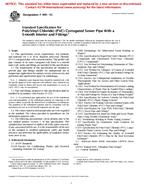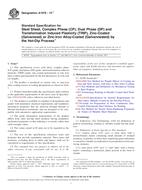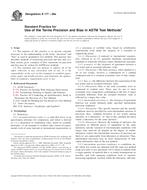1.1 This guide covers the techniques for obtaining approval for release of materials encountered in decontamination and decommissioning (D&D) from restricted use. This would be addressed in the decommissioning plan (E 1281). It applies to materials that do not meet any of the requirements for regulatory control because of radioactivity content. Fig. 1 shows the logic diagram for determining the materials that could be considered for release. Materials that negotiate this logic tree are referred to as “candidate for release based on dose.“
1.2 The objective of this guide is to provide a methodology for distinguishing between material that must be carefully isolated to prevent human contact from that that can be recycled or otherwise disposed of. It applies to material in which the radioactivity is dispersed more or less uniformly throughout the volume of the material (termed residual in bulk form) as opposed to surface contaminated objects.
1.3 Surface contaminated objects are materials externally contaminated with radioactive material. Provisions already exist for their release for recycle if it can be shown that they meet applicable federal and state regulations for surface contamination. Regulatory Guide 1.86 and DOE Order 5400.5 specify the upper limits for radioactive surface contamination on material to be released for unrestricted use.
1.4 The release of material containing residual radioactive material (except for 226Ra) in bulk form (for example, soil or slightly activated metal) is based on the demonstration that the dose to a member of the public will be lower than a specified value (proposed by the petitioner or defined by regulation) for its intended use and lower than a second specified value via the most restrictive plausible scenario. The first proposed value should be lower than the second since the dose to any member of the public (via the intended use scenario) will almost certainly be realized, whereas the dose from the alternate scenario will only accrue if an unintended (and presumably less probable) circumstance arises. Federal regulation already exists for the release of 226Ra contaminated soils.
1.5 Warning–Breathing of asbestos dust is hazardous. Asbestos and asbestos products present demonstrated health risks for users and for those with whom they come into contact. In addition to other precautions, when working with asbestos products, minimize the dust that results. For information on the safe use of chrysoltile asbestos, refer to “Safe Use of Chrysotile Asbestos: A Manual on Preventive and Control Measures.“
1.6 This standard does not purport to address all of the safety concerns, if any, associated with its use. It is the responsibility of the user of this standard to establish appropriate safety and health practices and determine the applicability of regulatory limitations prior to use. For a specific hazard see 1.5.

FIG. 1 Prerequisites for Material To Be Candidate For Release
Product Details
- Published:
- 06/01/2009
- Number of Pages:
- 6
- File Size:
- 1 file , 110 KB
- Redline File Size:
- 2 files , 210 KB


